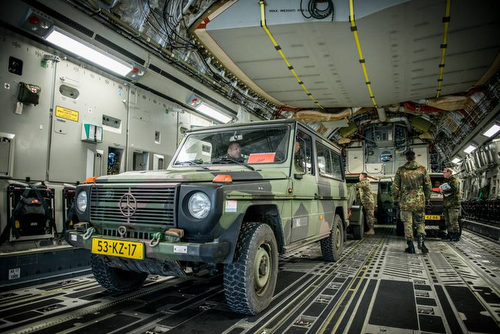Exercise Watch: ‚NATO’s new spearhead force gears up‘
Zur Beobachtung der neuen NATO-Speerspitze, der Very High Readiness Joint Task Force, ein Bericht auf der NATO-Webseite am (gestrigen) Donnerstagabend – ich erlaube mir mal, den hier komplett einzustellen (haben ist besser als brauchen):
NATO has a new ‘spearhead force’, known as the Very High Readiness Joint Task Force (VJTF), which the Alliance has started to test.
The VJTF is a brigade that will be able to deploy within 48 hours and will eventually include 5,000 troops. It is part of the NATO Response Forces (NRF), NATO’s high-readiness force comprising land, air, sea and Special Forces units capable of rapid deployment wherever needed. Both the NRF and its new ‘spearhead force’ aim to strengthen the Alliance’s collective defence capability and ensure that NATO has the right forces in the right place at the right time. They are a key component of what has been called the “Readiness Action Plan” agreed by NATO leaders at the Wales Summit in September 2014.
The VJTF has now reached interim capability and has started to go through a series of exercises, trials and evaluations, which will run throughout 2015. The first of these took place in Germany, 4-5 March, involving the 1st German-Netherlands Corps. The 1st German-Netherlands Corps is the NATO Response Force’s (NRF) standby land headquarters during 2015, so it is also acting as the Interim VJTF. The Corps spokesperson, Lt Col Paul Kolken stated:
“Being used as NRF (…) helps us to remain sharp and to set the standard within NATO rather than following it.” He continued: “We pride ourselves specifically for being quickly deployable, for the attitude to try out new concepts and to interact in peacetime and before deployments with the civil partners that we most likely will work with when in a mission area.”
This is the third time that this headquarters is on NRF standby, so it is well-suited for its VJTF duties. German Lt Col Axel Schmettkamp is the Director of the Joint Operations Center of the 1st German-Netherlands Corps:
“All that comes on top of our training and exercise schedule,” explains Lt Col Schmettkamp. “Quite a burden, but the necessity to do so is visible daily when watching the evening news. Moreover, personally, I think it is pretty exciting to play such an important role in the service of security.”
Ready…
The March exercise practised alert procedures and rapid-deployment preparations.
A C-17 aircraft landed at the civilian airport Münster Osnabrück, Germany. Then the vehicles and personnel of the Operational Liaison and Reconnaissance Team (OLRT) were packed and loaded onto the plane, which can carry six vehicles including trailers. This required a lot of precision work, but the Swedish and American loadmasters made sure all material was chained to the cargo floor for a safe flight.
The actual flight, however, did not take place. Not this time.
Steady…
The second phase of the exercise established the Initial Command Element.
Operating out of tents, its main task is to set up the communication and information systems to make sure the headquarters can effectively command and control the forces in the mission area.
“Our OLRT might deploy even within 48 hours after NATO has ordered this. They will establish first contacts with authorities and organisations in the mission area, find a location for the Initial Command Element and prepare for its arrival. A few days after that, the Initial Command Element will follow, build the corps headquarters, absorb the OLRT and start leading the operation,” explains Dutch Corporal Rick Klein.
Klein is responsible for building the headquarters and would therefore be among the first to be deployed. He has a great deal of experience to draw on, having served in the Royal Netherlands Army for 13 years, including two deployments to Afghanistan with his previous unit, the 43rd Mechanized Brigade from Havelte. He joined the headquarters of the 1st German-Netherlands Corps a year ago, as it prepared for the NRF rotation.
„Before an exercise or deployment I am busy preparing the maps that are needed. As soon as we’re in the mission area, I take care of building the Initial Command Element. With my fork-lift, I put the flooring material, the tents and furniture as close to the building location as possible,” explains Corporal Rick Klein, adding that rapidly setting up over 20 tents is a great team-building activity
Go!
In a real crisis-response situation, the third and final phase is to deploy the remaining personnel to reach full operational capability and effectively receive and command the NATO follow-on forces.
Klein is not fazed by the possibility of a real deployment: „I talk about possible implications with my girlfriend. She is very much aware what it means to be on NRF standby, but actually it’s nothing different from my previous job. Such is a soldier’s life.”
This first exercise will be followed by others in April and June:
“Due to the changed security situation at the borders of NATO’s eastern member states, NATO adapted quickly and tasked the NATO Response Force – or NRF – to execute an alert exercise in April as well as a deployment exercise in June,” says German Lt Col Axel Schmettkamp.
The VJTF should be fully operational as of 2016 and ready to respond wherever and whenever needed to any challenge that may arise on NATO’s periphery.
(Text, in diesem Fall, komplett: NATO; Foto: NRF training at the Münster/Osnabrück Airport (FMO) – 1. Deutsch/Niederländisches Korps)




Anstatt so ein mediales Tohuwabohu um die Very High Readiness Joint Task Force zu veranstalten sollten sie diese Truppe einfach mal kommentarlos in den Baltikum verlegen und DANN darüber berichten.
Also VJTF ist kein zusätzlicher (stehender) Verband sondern ein Element der NRF. Und daß das ICE 48h NTM hat ist ja nicht außergewöhnlich, zumal es davor ja auch einen politischen und planerischen Vorlauf gibt (quasi als WARNO).